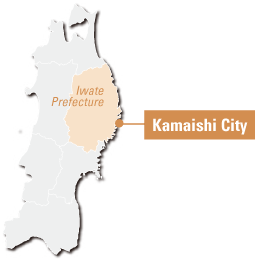INDEX
- English
- 日本語

Panels and pictures help to inform visitors about disaster preparedness - English
- 日本語

The newly established Inochi o Tsunagu Miraikan in Kamaishi City


Kikuchi Nodoka
May 2020
Sharing Stories of Disaster Preparedness

Kamaishi City, Iwate Prefecture was one of the hardest hit areas during the Great East Japan Earthquake in March 2011. The Inochi o Tsunagu Miraikan was recently established there as a center for disaster preparedness education, passing on the history of the tsunami disaster to future generations. Kikuchi Nodoka, a storyteller at the Miraikan, shares her experience of the disaster that hit her hometown with visitors from Japan and overseas. She explains how important it is to protect your life in a disaster.

In March 2019, the Inochi o Tsunagu Miraikan was established in Unosumai Town, Kamaishi City, Iwate Prefecture. Adjacent to Unosumai Station on the Sanriku Railway Rias Line, the facility is designed to pass on the history of the disaster to future generations and promote disaster preparedness education. During the initial year of its establishment, the center has seen a total of over 68,000 visitors, including disaster prevention experts from the local communities as well as from all over Japan and around the world.
The facility has an exhibition room with displays including panels and photographs that introduce the destruction in Kamaishi, the history of recovery from the disaster, the initiatives to promote disaster preparedness education, and items such as a clock that stopped ticking at the moment the tsunami hit. Visitors can access a virtual tsunami system using computer graphics technology.
One of the exhibits chronologically introduces evacuation protocols and detailed routes taken by 570 students at Kamaishi Higashi Junior High School and Unosumai Elementary School. Both schools were completely destroyed by the tsunami, but all of the students escaped the surging sea by running 1.6 kilometers for 30 minutes to the surrounding hills. This evacuation gathered a lot of media attention as a successful example of disaster management education.
“The tsunami will come soon after the shaking stops. I must evacuate to the surrounding hills as quickly as I can. As soon as this idea entered my mind, my body reacted, thanks to the routine emergency drills that I had experienced before,” says Kikuchi Nodoka, a storyteller at the Inochi o Tsunagu Miraikan.

Kikuchi was a third-year student at Kamaishi Higashi Junior High School when the Great East Japan Earthquake struck on March 11, 2011. She, her classmates and teachers fled to the surrounding hills to escape the surging sea as a siren wailed continuously across the area. They ran for their lives along with the students from the adjacent elementary school, with whom they had conducted regular evacuation drills to ensure that they survived in an emergency.
The Sanriku region, where Kamaishi is located, has a history of significant seismic activity and devastating tsunami damage. In an attempt to prepare the children for another disaster, the Kamaishi Government advocates disaster management education. Consequently, 1,927 elementary students and 999 junior high school students survived the 2011 disaster, a survival rate of 99.8%, but meanwhile, the city was entirely devastated. In the city, approximately 1,100 people were killed or listed as missing.
“Many of the schoolchildren in the city survived the tsunami, but so many people in our region died. I have come to realize that our generation must address regional disaster management issues seriously,” Kikuchi says.
Having worked as a storyteller at the facility since its establishment, Kikuchi shares her experience and disaster-prevention education with visitors. She has been invited to address audiences at conferences and symposiums focused on disaster prevention initiatives. Through these activities, Kikuchi shares lessons learned from the disaster.
“Through a number of activities, I have built up a network of people engaged in regional disaster management activities across Japan," Kikuchi says. “Going forward, I will stay active in passing the insights and expertise learned from my colleagues on to the youth in local communities.”
The Inochi o Tsunagu Miraikan holds exhibitions on new themes almost every month. Last November, for example, the facility hosted an exhibition displaying photos of Unosumai Town before the disaster which attracted visitors from across the region. People appreciated the exhibition as it reminded them how the town once looked at a time when recovery efforts including the development of new facilities and roads as well as land readjustment projects are changing the city’s landscape significantly.

Also displayed in the exhibition hall is a typical example of an evacuation shelter space allocated to a family of four in the wake of the disaster, which was reproduced with reference to the memories of the evacuees and photographs taken on site.
Struck by the exhibition showing that the tsunami evacuees had to stay in a small living space surrounded by cardboard partitions with limited supplies, overseas visitors to the facility found their visit to be a significant opportunity to understand the need for improvements in evacuation shelter and relief supplies delivered to those affected.
International rugby fans visited the Inochi o Tsunagu Miraikan before and after the games when the 2019 Rugby World Cup was held in Japan.
“I was so glad that so many people from around the world came to visit the facility. I was deeply touched when I saw visitors in tears at the exhibits as if they were also disaster victims.”
When asked about the challenges confronting disaster prevention, Kikuchi says without hesitation, “It’s indifference. You cannot forget the people who sacrificed their lives to save other citizens who were not prepared for the disaster. Quite a few of the tsunami victims included ordinary citizens with a keen interest in disaster prevention calling for evacuation as responsible members of local community organizations.” Indifference puts you and the people around you at risk. I will stay committed to local community development and make people realize the great importance of disaster prevention.”
(This is a revised version of the article that appeared in the December 2019 issue of Highlighting Japan.)

